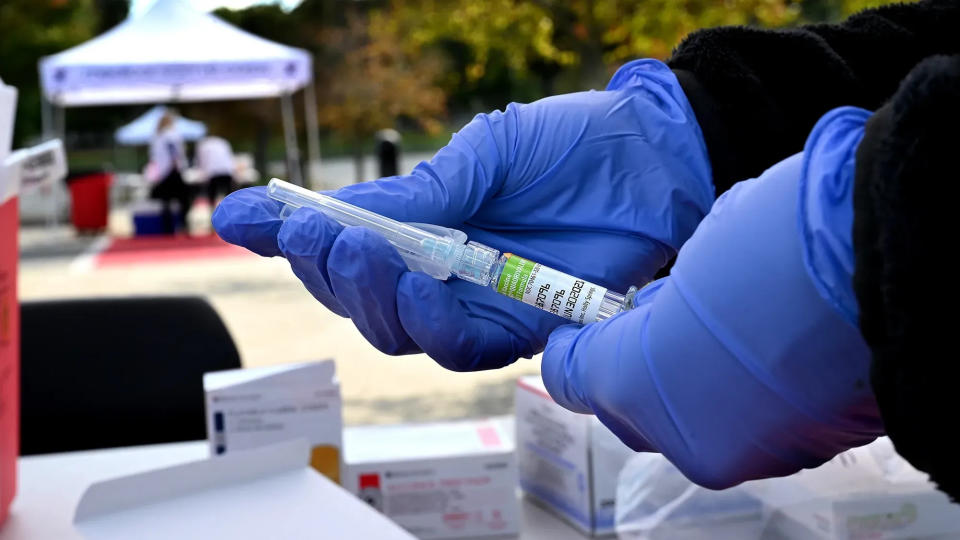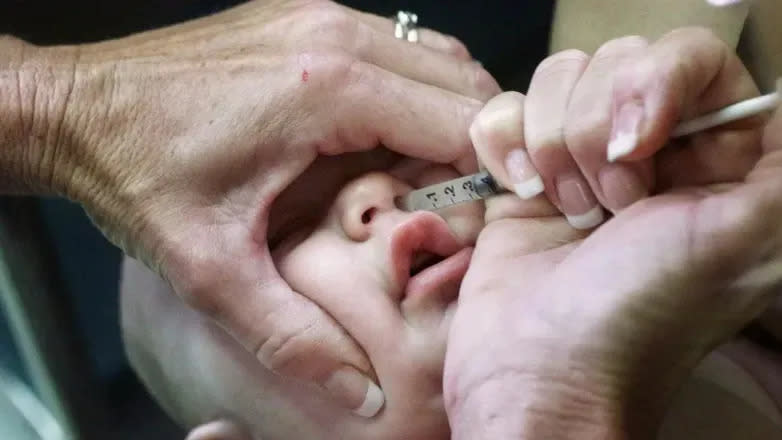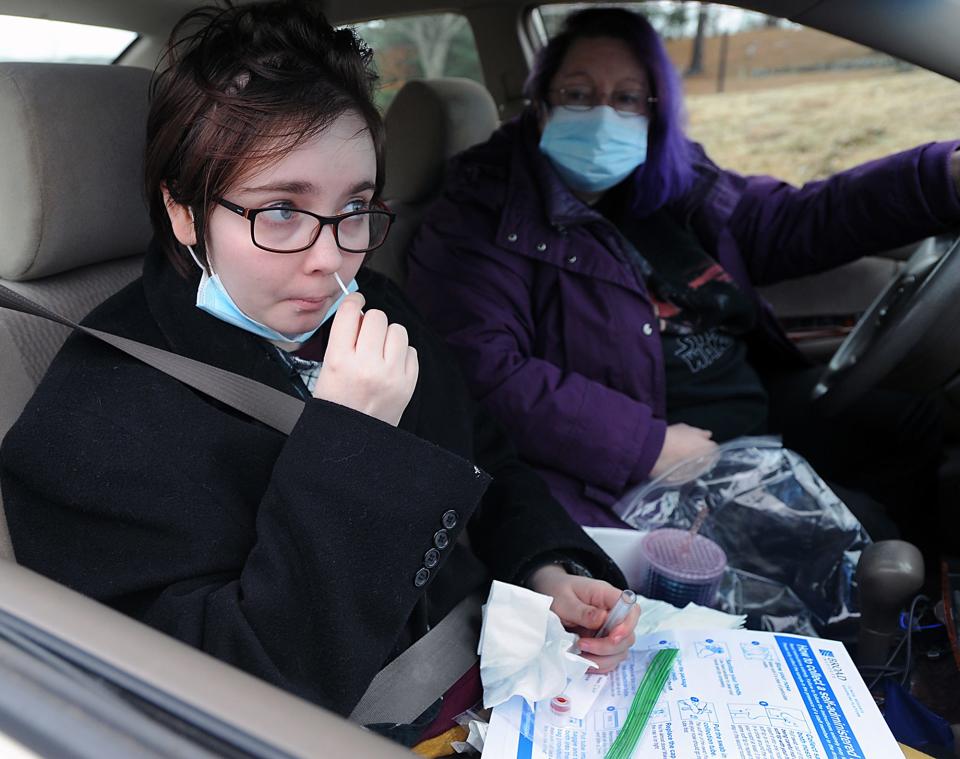Mass. public health experts wary of increased cases of flu, RSV and COVID-19
- Oops!Something went wrong.Please try again later.
BOSTON — With colder temperatures leading people to spend more time indoors, public health experts and health care professionals are concerned about an increasing viral mix of COVID-19, RSV and the flu, particularly with staffing shortages and overflowing emergency rooms continuing to stress the state's medical care system.
Places ranging from movie theaters to the State House made masking optional earlier this year, but COVID-19 variants are continuing to develop. In recent weeks, cases of other respiratory illnesses — the respiratory syncytial virus, or RSV, and the flu — are also rising.
“Everything is happening at an accelerated pace,” said Dr. Huan Ngo, chief medical officer at Signature Healthcare Brockton, in regards to an increase in respiratory illness cases. “This is all happening with COVID-19 underlying.”

In Massachusetts, the three-week average RSV positivity rate hit 23.1% in mid-November, according to the latest CDC figures available, a stark increase from just over 3% at the end of August.
The flu has also seen record spikes and hospitalizations throughout the state, according to a recent report from the Department of Public Health. Health officials report flu severity as “very high” as flu-like illness visits at health care facilities have more than doubled from last year to almost 6% of visits.
Flu season is here: Massachusetts medical experts answer your questions about vaccines
“I've been concerned about this for months,” Ngo said. “Everybody is getting (sick). It is challenging to manage more sick people than you're used to.”
Ngo said the flu and RSV historically rise during the winter, but hospitals faced an inordinate increase in sick patients this year as early as September.
Although it doesn’t cause severe conditions in most older kids and adults, Ngo said, RSV can pose a dangerous threat for the elderly, people with a weakened immune systems and young children. Illnesses like RSV can cause respiratory distress and blockage of the airways.
Will it get worse?
But public health care experts say current state trends are only the beginning of what’s to come.
“It’s been a tough recent time with flu and RSV,” said Jonathan Levy, chair of the department of environmental health at Boston University’s School of Public Health. “It’s quite likely that things are going to get worse in coming months.”
To help mitigate the stress on the health care industry, state medical group leaders say people need to take more precautions to protect themselves.
Are more kids sicker?: Doctors discuss RSV, impact of youngsters who avoided germs during COVID-19
"Our level of concern has been elevated to the point at which we are compelled to share and recommend mitigation measures that can help to prevent illness," said Massachusetts Medical Society President Ted Calianos, Massachusetts Academy of Family Physicians President Emily Chin and American Academy of Pediatrics Massachusetts Chapter President Mary Beth Miotto, in a joint statement.
They say all children older than 6 months should be vaccinated — including boosters — against the flu and COVID-19, and that people should wash their hands regularly. And they say anyone gathered in crowded indoor spaces, including symptomatic children, should consider wearing masks.
Such precautions will "reduce interruptions to in-person learning and other children's activities that can result from outbreaks caused by viral infections," the trio said.
Reducing the spread: RSV infections are straining hospitals' emergency departments
The early onset of flu and RSV season prompted some health care experts to hypothesize that people's immune systems were not ready for typical winter respiratory illnesses after more than two years of masking and lockdowns.
Levy said we could spend time discussing the causes of the "tripledemic," but it’s more important to act and deal with its impact.

“There's been a lot of debate about whether we're seeing a problem where our bodies haven’t seen these viruses for a while versus the immune system having been depleted from COVID infection and kind of everywhere in between,” he said.
“Regardless of the cause of it, we have to deal with the cost.”
Tired workforce
Ngo wanted to become a health care professional and help people feel better since he was 5 years old.
For almost 20 years, he has treated community members at Signature Healthcare, first as chief of the emergency department and now as the hospital’s administrative leader. But the conditions he has seen in the past two years, he said, have been entirely out of the ordinary as hospitals face massive staff shortages and overwhelmed emergency centers.
“The situation that health care is in right now is something that none of us have ever seen, including me,” Ngo said. “It's exacerbated by the viral illnesses, but a lot of it started with the pandemic.”
He said that at COVID-19’s onset, helping patients initially energized providers. But as time went on, stamina within the industry began to buckle.

“We always thought that there would be light at the end of the tunnel, we always thought, you know, I will get through this, and unfortunately, that's never happened,” Ngo said. “There's just an enormous amount of people just leaving the industry. They're burned out. It's not right or wrong, that's just what happened, and now the health care industry is extremely short-staffed.”
In late November, Gov. Charlie Baker said the industry needs to reimagine care as hospitals throughout the state have experienced shortages for the past year.
"There's this giant staffing problem running across the system," he said during the Massachusetts Association of Health Plans conference. "That staffing problem is doing significant damage to the normal process by which the system works."
Hospital crisis: Staff shortages, long patient wait times plague area medical centers
A recent Massachusetts Health and Hospital Association report reveals that about 19,000 full-time positions statewide remain unfilled, putting Massachusetts hospitals on track to pay more than $1 billion for temporary nurses.
Nursing care positions had the highest vacancy rate among survey respondents, at 56%. Home health aides (34%), pulmonary function technicians (35%), mental health workers/technicians (32%) and infection control nurses (26%) also reported high vacancy rates.
“Regionwide, every hospital system is fighting for the same employees,” Ngo said. “The prices get driven up, and that affects every corner of health care from the hospital to the outpatient setting, to the nursing homes and the rehab facilities where they're struggling with staffing — everything's interconnected.”
The MHA reported that Massachusetts hospitals paid about $181 million for temporary nurses in 2020 and $328 million in 2021.
Shortages have led to increased waiting times and a decreased capacity to treat patients — especially as more sick patients with respiratory illnesses turn to emergency rooms. Some hospitals have had to redirect patients to local facilities due to a lack of resources.
“We are a community hospital,” Ngo said of Signature Healthcare Brockton. “We don’t have a pediatric intensive care unit.”
For many young patients sick with the flu and RSV, he said the goal for providers is to stabilize them and transfer them to facilities like Boston Children’s Hospital. At the beginning of November, Boston Children's representatives told The New York Times that they had postponed some elective surgeries to make room for more patients with respiratory illnesses.
But at some point, Ngo said no more beds were available at these larger hospitals for transfers. So they pivoted.
“There were many times where we were trying to transfer these kids out of state to Connecticut, to Maine, to Vermont.”
Black and Latino residents at risk
With the trifecta of virus cases showing no signs of declining, community leaders worry about how this will affect communities of color, already, which have been significantly impacted by the pandemic in the past two years.
“We still have COVID-19 around. We still have a lot of inequities in our community,” said Paola Martinez, La Colaborativa’s new health equity director, about community preparedness.
Over two years of dealing with a pandemic, the DPH reports that Latino and Black residents experience the highest case rates, at almost 25% and 17% respectively, of COVID-19 cases per 100,000 residents.
Similarly, according to the Department of Public Health, more Latino and Black residents have been hospitalized for flu-related diagnoses this year.
Although there isn’t demographic data available for RSV infections, public health experts say many Black and Latino families with children will likely struggle to deal with the long-term consequences of the disease.
As policymakers continue to take a “laissez-faire” approach to protect residents, Levy said this would affect disadvantaged people the most.
“It’s about the risks of infection,” he said. “What are the consequences? That's where you see the disparities emerge — what households and families are better able and better equipped to try to weather the storm.”
Getting sick is more than getting over respiratory illness-related symptoms, Levy said. For some families, it can affect their finances as individuals may need to miss work without sick leave to take care of themselves or their family members, and the quality of available health care isn’t the same for everyone statewide.
While many communities have changed perspectives about the pandemic and preventative measures, La Colaborativa, a nonprofit organization based in Chelsea supporting Latino immigrant communities in Greater Boston, has not.
Particularly as Latino and Black communities continue to report the highest cases of both COVID-19 and the flu.
“People think that COVID is the news of yesterday; for us, it continues to be the news of today,” said Gladys Vega, La Colaborativa’s executive director. “Your good reality, that is my sad reality.”
La Colaborativa continues to help families dealing with the aftermath of the pandemic, including helping with issues like unstable housing, unemployment, food insecurity and immigration status.
Community advocates like Vega and Martinez hope policymakers from the local to the federal level will work together to take more preventive measures regarding respiratory illnesses during the colder months.
“The incidence of COVID-19, RSV and influenza in the ‘tripledemic,’ is just serving a purpose of unveiling the challenges that have been undermining our communities for a long time,” said Martinez. “As public servers, authorities should focus on addressing the foundation of these stratifications by developing policies and programs that provide equitable access to basic services, such as housing, to all communities.”
This article originally appeared on MetroWest Daily News: Viral mix of COVID, flu and RSV further pressures Mass. health workers

